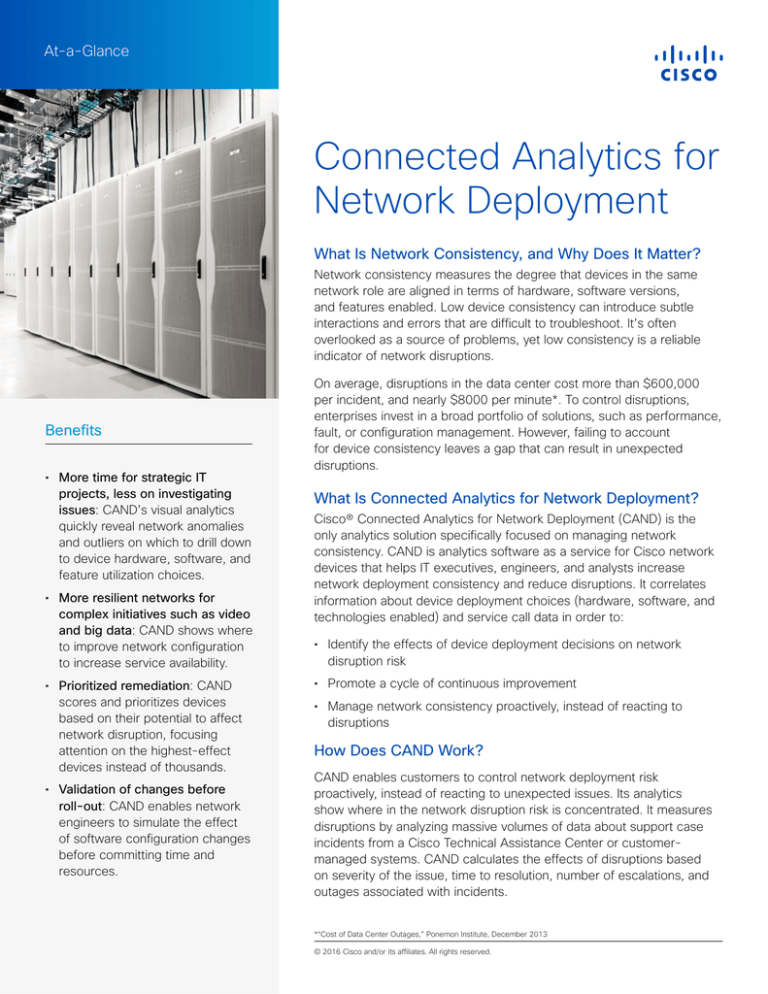
At-a-Glance
Connected Analytics for
Network Deployment
What Is Network Consistency, and Why Does It Matter?
Network consistency measures the degree that devices in the same
network role are aligned in terms of hardware, software versions,
and features enabled. Low device consistency can introduce subtle
interactions and errors that are difficult to troubleshoot. It’s often
overlooked as a source of problems, yet low consistency is a reliable
indicator of network disruptions.
Benefits
• More time for strategic IT
projects, less on investigating
issues: CAND’s visual analytics
quickly reveal network anomalies
and outliers on which to drill down
to device hardware, software, and
feature utilization choices.
• More resilient networks for
complex initiatives such as video
and big data: CAND shows where
to improve network configuration
to increase service availability.
• Prioritized remediation: CAND
scores and prioritizes devices
based on their potential to affect
network disruption, focusing
attention on the highest-effect
devices instead of thousands.
• Validation of changes before
roll-out: CAND enables network
engineers to simulate the effect
of software configuration changes
before committing time and
resources.
On average, disruptions in the data center cost more than $600,000
per incident, and nearly $8000 per minute*. To control disruptions,
enterprises invest in a broad portfolio of solutions, such as performance,
fault, or configuration management. However, failing to account
for device consistency leaves a gap that can result in unexpected
disruptions.
What Is Connected Analytics for Network Deployment?
Cisco® Connected Analytics for Network Deployment (CAND) is the
only analytics solution specifically focused on managing network
consistency. CAND is analytics software as a service for Cisco network
devices that helps IT executives, engineers, and analysts increase
network deployment consistency and reduce disruptions. It correlates
information about device deployment choices (hardware, software, and
technologies enabled) and service call data in order to:
• Identify the effects of device deployment decisions on network
disruption risk
• Promote a cycle of continuous improvement
• Manage network consistency proactively, instead of reacting to
disruptions
How Does CAND Work?
CAND enables customers to control network deployment risk
proactively, instead of reacting to unexpected issues. Its analytics
show where in the network disruption risk is concentrated. It measures
disruptions by analyzing massive volumes of data about support case
incidents from a Cisco Technical Assistance Center or customermanaged systems. CAND calculates the effects of disruptions based
on severity of the issue, time to resolution, number of escalations, and
outages associated with incidents.
*“Cost of Data Center Outages,” Ponemon Institute, December 2013
© 2016 Cisco and/or its affiliates. All rights reserved.
At-a-Glance
How is CAND different?
• CAND was developed by Cisco
network experts. Its analytics use
25 years of network plan, design,
manage, and operate intellectual
capital from global leadership.
• CAND is built on Cisco’s big data
platform. It’s able to analyze vast
quantities of network data previously
impossible with scripts and
spreadsheets and more quickly than
with traditional business intelligence
systems.
• Unlike network configuration and
change management systems or
network management systems,
CAND analyzes service request data
to focus deployment and change
efforts on the devices most affecting
service availability.
CAND correlates this disruption data with network deployment data
(hardware, software, and feature choices) and applies visualization
analytics to cluster devices according to their network role and effects
on network risk. With CAND, network operations teams can:
• See where disruption risk exists in the network
• Highlight the effect of deployment changes in the network
• Model the effects of changes before committing to them
• Prioritize devices to be fixed based on their contribution to network
risk
This saves network experts’ time, uses IT spend efficiently, and
promotes available networks.
CAND communicates network deployment posture using three indexes
created by Cisco network experts, shown in Figure 1.
Figure 1. CAND Indexes
• Network disruption index: Measures the severity of network
disruptions (outages, degradation, and so on). Higher score/volatility
indicates unwanted service outages and/or degradation. Viewable by
type of insight (for example, hardware, software, and operations).
• Network consistency index: Shows how consistently devices
supporting similar functions in the network are deployed (or, how
closely devices in a network role conform to a policy master if one
exists). Higher score indicates increasing drift from policy and similar
devices in a role.
• Feature utilization index: Measures network sophistication using
weighted score of device technologies and features. A higher score
indicates the network is delivering increasingly complex business
services and is sensitive to risk from the other indexes.
With CAND, customers can drill down into hardware, software, and
features to promote a structured process for resolving network
disruptions (Figure 2):
• Create baselines for network deployment and support case KPIs and
trends
© 2016 Cisco and/or its affiliates. All rights reserved.
At-a-Glance
Why Cisco?
• Compare KPIs against those of peers and industry
With the number of connected
devices and the amount of data rapidly
increasing, networks are more complex
and dynamic than ever before, creating
optimization challenges. Cisco is
uniquely qualified to deliver analytical
solutions that promote the delivery of
complex network services on a global
scale. We combine data at the edge
and data in motion with the power of
our networking expertise to create
analytics solutions that lead to better
outcomes for you and your customers.
• Analyze network changes over time
• Identify potential causes of disruptions
• Simulate the effects of software changes
• Prioritize remediation and network improvement planning
Figure 2. CAND Structured Process for Resolving Network Disruptions
For More Information
For more information about the
Connected Analytics for Network
Deployment, visit our website. To
request a private briefing, contact us
at sales-connectedanalytics@cisco.com.
CAND automatically clusters devices by network role. The device
clusters are color-coded to show which devices have the highest
disruption risk. User-configurable benchmarks can be overlaid in order
to show how the current network state compares to the target state.
CAND also shows how network KPIs compare with others in an industry
and indicates whether an organization is leading, lagging, or tracking its
peers and competitors. (See Figure 3.)
Figure 3. CAND Deployment Analysis Summary
© 2016 Cisco and/or its affiliates. All rights reserved. Cisco and the Cisco logo are trademarks or registered trademarks of
Cisco and/or its affiliates in the U.S. and other countries. To view a list of Cisco trademarks, go to this URL: www.cisco.com/
go/trademarks. Third-party trademarks mentioned are the property of their respective owners. The use of the word partner
does not imply a partnership relationship between Cisco and any other company. (1110R) 02/16






